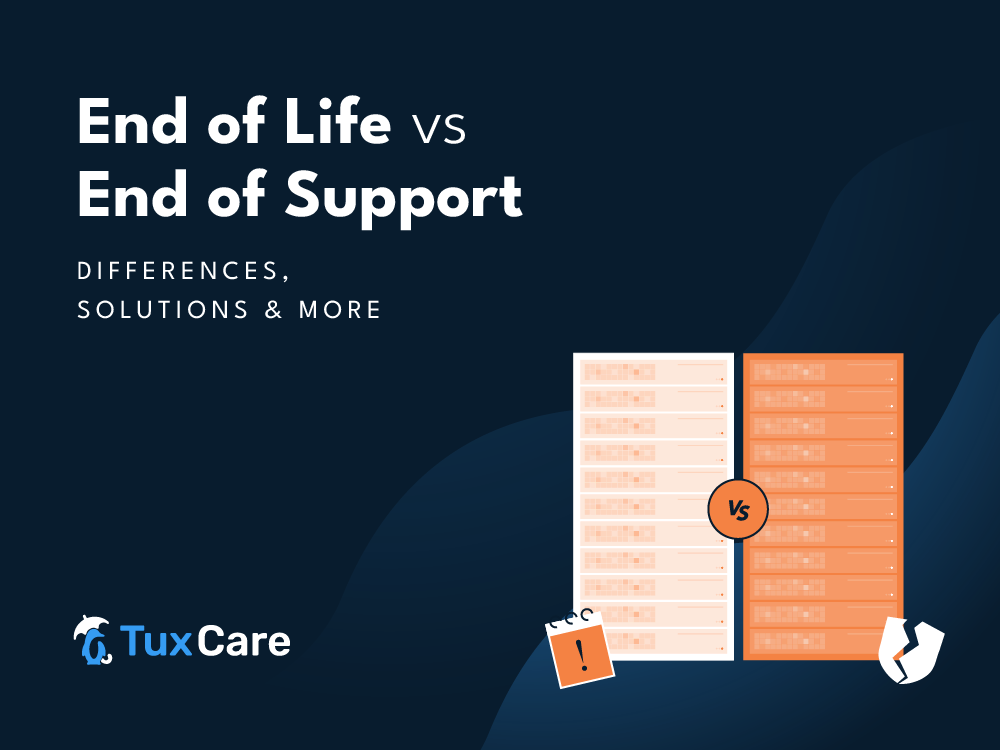Key Takeaways
- End of Life (EOL) means the system stops receiving updates entirely — no patches, no features, no vendor maintenance.
- End of Support (EOS) means the vendor ends technical support and assistance.
- TuxCare’s Endless Lifecycle Support keeps your EOL Linux systems secure and compliant without immediate migration.
Are your Linux systems past their end of life (EOL)? You’re not alone — but ignoring it can expose your infrastructure to serious risk. EOL leaves systems vulnerable to security threats, compliance failures, and operational instability.
This article explains the difference between End of Life (EOL) and End of Support (EOS), why it matters for Linux system administrators, and what actions you should take — fast.
What Do End-of-Life (EOL) & End Of Support (EOS) Mean?
Generally, End of Life (EOL) and End of Support (EOS) indicate the same thing: that software no longer receives updates from the manufacturer. However, there are subtle but important differences between the two.
End of Life (EOL)
EOL means the end of product lifecycle and that the product is completely discontinued by the vendor. The software is considered obsolete and no longer receives any updates, including security patches, bug fixes, and performance improvements. Examples include CentOS 7 EOL, Ubuntu 18.04 EOL, and Python 2.7 EOL.
End of Support (EOS)
End of support (EOS) typically refers to the end of technical support services — such as assistance from the vendor, access to new documentation, or ability to open support tickets. Some updates may still be available, but you’re essentially on your own.
End of Life vs End of Support: Key Differences
The terms End of Life (EOL) and End of Support (EOS) are often used interchangeably, but they can affect your Linux environment in different ways. Understanding these differences helps in planning migrations, risk mitigation, and compliance strategies.
Development Stops vs Support Ends
EOL marks the end of active development. The vendor halts all work on security updates, new features, or compatibility updates. The software becomes frozen — no longer evolving to support new hardware or standards.
EOS, on the other hand, often means support ends, but limited updates may continue, especially in extended support agreements.
Obsolete vs Self-Supported
EOL software is abandoned by the vendor and often phased out across the ecosystem.
With EOS, the software may still be in limited use, but the burden of maintaining it shifts entirely to your internal team.
Solutions to Manage End of Life & End of Support
When your Linux systems hit EOL or EOS, you face security risks, compliance issues, and operational headaches. Here are practical ways to secure and extend the life of unsupported systems:
TuxCare’s Endless Lifecycle Support
TuxCare’s Endless Lifecycle Support (ELS) delivers ongoing security patches for end-of-life Linux distributions including CentOS 6 support, CentOS 7 support, CentOS 8 support, CentOS Stream 8 support, Oracle Linux 6 support, Oracle Linux 7 support, Ubuntu 16.04 support, Ubuntu 18.04 support, and Ubuntu 20.04 support. This lets you keep your outdated Linux systems secure and compliant even after the official support ends.
Migrate to a Supported OS
When possible, the best long-term solution is to upgrade or migrate to a supported Linux operating system. This ensures ongoing access to security updates, new features, and vendor support. However, this approach requires time, testing, and budget — and may not be always practical for older systems due to compatibility issues.
Use Containers to Isolate EOL Systems
For legacy systems that can’t be easily upgraded, consider containerizing them with tools like Docker or Podman. While containers don’t solve patching, they help isolate vulnerable systems, limit attack surfaces, and improve portability for future migration.
Risks of Ignoring EOL and EOS & Their Impact on Your Business
Running unsupported Linux systems may seem harmless — until a vulnerability hits. Ignoring EOL and EOS can lead to security breaches, compliance failures, and unexpected downtime. Here’s what’s at stake.
Security Vulnerabilities
Unpatched EOL systems are sitting ducks for cyberattacks. After security updates cease, every newly discovered vulnerability becomes an unaddressed entry point into your infrastructure. It’s not a matter of if a breach occurs, but when.
Compliance Failures
Most security standards, including PCI-DSS, HIPAA, and ISO 27001, often require using supported software. Running EOL systems can lead to audit failures, legal penalties, and lost certifications.
Downtime and Recovery Costs
Outdated systems with no vendor support are harder to recover when things break. Without official patches or assistance, fixes are riskier, downtime lasts longer, and recovery becomes costly and complex.
Missed Innovation
Unsupported systems can’t take advantage of modern tools, automation, or performance enhancements. Over time, this creates technical debt that slows down teams and increases infrastructure costs.
Why Do Vendors Declare EOL or EOS?
Software vendors declare End of Life or End of Support to shift focus and resources to newer products. Maintaining outdated software is costly, risky, and slows innovation. As older systems age, they become harder to secure, maintain, and integrate with modern technologies.
By setting lifecycle deadlines, vendors:
- Reduce technical debt
- Improve focus on newer, more secure products
- Encourage users to adopt supported versions
- Cut long-term support and maintenance costs
EOL vs EOS in Hardware
Hardware lifecycles follow the same pattern. When devices reach EOL, vendors stop producing parts or firmware updates.
EOS usually comes first — signaling that tech support or repairs will no longer be available. For critical infrastructure, this means higher risk of downtime, especially if parts fail and replacements are unavailable.
Whether software or hardware, knowing the EOL/EOS status lets you plan ahead and avoid operational surprises.
EOS vs EOL Indicators
To help you differentiate clearly, here’s a side-by-side breakdown of the most common indicators:
| Indicator | End of Support (EOS) | End of Life (EOL) |
|---|---|---|
|
Vendor Security Patches |
Sometimes still available |
Completely discontinued |
|
Technical Support |
Discontinued |
Discontinued |
|
Feature Updates |
Stopped |
Stopped |
|
Compliance Status |
Often non-compliant |
Always non-compliant |
|
Migration Urgency |
Medium — short-term risk |
High — immediate risk |
|
System Operation |
Still works, may receive some updates |
Still works, receives no updates |
|
Vendor Statement |
Official notice from the vendor announcing the specific EOS date. |
Official announcements from the vendor declaring the end of the product’s lifecycle. |
End of Life (EOL) or End of Support (EOS) Best Practices
When a Linux system reaches EOL or EOS, your priority should be to reduce exposure and buy time for safe migration. Here’s how:
Implement Extended Support
Use solutions like TuxCare’s Endless Lifecycle Support to continue receiving critical security patches for EOL systems. It offers a reliable and cost-effective way to restore compliance and protect against zero-day threats. ELS for Linux distributions provide security updates for critical packages including the Linux kernel, Python, Apache, PHP, MySQL, glibc, OpenSSL, and more.
Check out TuxCare’s CVE tracker page to view the list of all supported packages.
Isolate Your Systems
Place unsupported systems in segmented networks. Apply strict firewall rules, disable non-essential services, enable Multi-Factor Authentication (MFA), and monitor for anomalies. Isolation limits blast radius if an exploit occurs.
Begin Migration Planning
Extended support is not a permanent fix — but it gives you breathing room. Use this time to evaluate supported distributions, assess application dependencies, and create a realistic, phased migration plan.
EOL and EOS Don’t Have to Be Roadblocks
Just because your Linux systems have reached End of Life or End of Support doesn’t mean you’re out of options. With the right support and best practices, you can keep legacy systems secure, compliant, and operational — without rushing a risky migration.
Stop worrying about unpatched vulnerabilities and compliance gaps. Talk to our Linux security experts today to see how TuxCare’s Endless Lifecycle Support (ELS) delivers ongoing security patches and protection long after vendor support ends.



 Documentation
Documentation Login
Login





